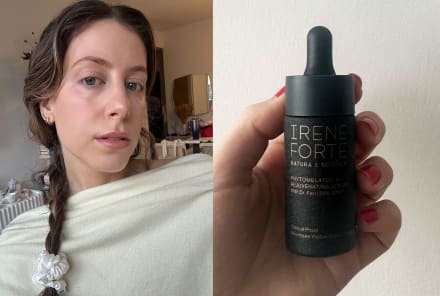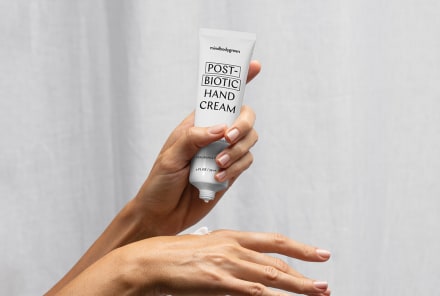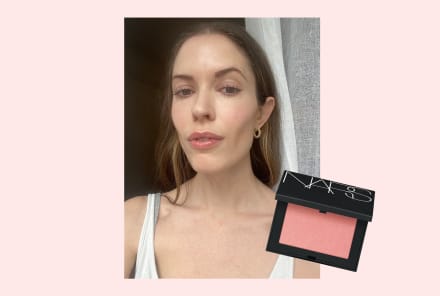Advertisement
Natural Beauty — Your Ultimate Guide To Choosing The Best Natural Beauty Products
When making choices to support a healthier lifestyle, many individuals overlook the safety of their beauty and/or personal care products. But they shouldn’t: Not only is skin your largest organ, but what is applied to the skin is absorbed by the body (if you’re suspect, just think about the efficacy of transdermal birth control or nicotine patches). As a professional with 15 years of experience as a makeup artist and 10 years of experience in naturals specifically, I have developed an expertise in which products, ingredients, and methods are best. So if you’re taking the time—and spending the money—to buy healthier, organic food, it’s about time you understand what you’re putting on your skin.
An introduction to clean and natural beauty.
In order to understand the context, here’s some clean beauty 101: The personal care industry (meaning things like lipstick, shampoo, lotion, deodorant, toothpaste) is completely unregulated in the United States. In layman’s terms, this means there is no third party, like the FDA, monitoring the safety of the products most of us use multiple times a day.
As if that weren’t troubling enough, the United States hasn’t passed a major federal law to regulate the safety of these personal care products’ ingredients since 1938. To date, the United States has "partially banned" the use of only 30 ingredients in personal care products, and when it comes to chemicals of concern, they can do and say whatever they want, without regulation or repercussion. Comparatively, the European Union has more rules and has banned more than 1,300 chemical ingredients for use in personal care products, in addition to restricting the allowable concentrations of over 250 additional ingredients.
This means that the onus is on you, and on us, to be educated consumers and use products from brands with trust, using ingredients that are safe. All of this information can seem daunting at first, but trust that the learning curve is only temporary and you’re doing this for the good of your health and the environment. Start with baby steps when making the change by swapping out products as you finish each bottle. This makes the switch less wasteful and more affordable. As you analyze ingredient lists, do so with the following ingredient "screening" in mind, knowing that you may need to weigh your options:
Ingredients to avoid in personal care products:
SLS and SLES surfactants.
These make a product lather, which can cause skin irritation1 or trigger allergies. SLES is often contaminated with 1,4-dioxane, a by-product of a petrochemical process called ethoxylation, which is used to process other chemicals in order to make them less harsh.
Parabens.
A class of preservatives commonly used to prevent the growth of bacteria and mold in products. Parabens are endocrine (or hormone) disrupters2, which may alter important hormone mechanisms in our bodies.
Synthetic fragrances.
An engineered scent or flavoring agent that may contain any combination of 3,000-plus chemical ingredients, including hormone disrupters and allergens3, but because of federal law, these formulas are protected as a "trade secret" and companies are allowed to not disclose what the actual ingredients are. They’ll typically label it as "fragrance."
Phthalates.
Labeled as DBP, DEHP, DEP, and others, these are plasticizing chemicals used to make products more pliable or to make fragrances stick to skin. Phthalates disrupt the endocrine system2 and may cause birth defects.
Hydroquinone.
Most commonly found in skin-lightening creams, this skin-lightening chemical inhibits the production of melanin4 and is linked to cancer, organ toxicity, and skin irritation.
Petrolatum.
Commonly listed as petroleum jelly, paraffin oil, or mineral oil, this is common in many beauty and personal care products. It is a by-product of the oil-refining process and definitely not a sustainable or eco-friendly ingredient choice. Petrolatum is odorless and colorless, it has an inherently long shelf life, and is a cheap ingredient, which makes it a popular one, but it is a possible carcinogen.
If you don’t know or can't understand the ingredient label—call the company, ask them about it, and don't hang up until they answer your question. This practice will encourage more companies to be transparent with their ingredients.
Best natural-beauty products for the face.
A great place to start when thinking about products for the face is to get to know carrier oils like argan or jojoba and essential oils like rose or lavender, and finding out what combination works best for your skin. Oil formulations for a day and night oil are really healing and don't require preservatives as they are shelf stable. Nervous about using oil on your face? The truth is, if you have been using lotion, you have always been using oil to moisturize. Lotion is just oil, whipped with water, which leaves you with a white lotion and is a lighter, less concentrated formula for moisturizing. The issue with lotion—don't worry; there are many nontoxic natural lotion products on the market—is that whenever you use water in a product, you then need to figure out a way to preserve it, as water grows bacteria. And that is one of the reasons clean beauty consumers LOVE oils or serums; they are more concentrated, and you don't need to worry about the preservative problem.
How to choose the best face oils for your skin type.
For oily skin, choose a lighter oil like argan and for dryer skin a jojoba and avocado are a great choice. Have sensitive skin that tends toward redness? A face oil with rose in it is a great choice to calm the skin.
When choosing a daytime product for your face, it is good to keep in mind some general knowledge about essential oils, especially in the case of photosensitive essential oils.
While we love citrus oils like bergamot, orange, grapefruit, and lemon for their refreshing scent, these essential oils are photosensitive, greatly increase UV sensitivity, and should be avoided while in the sunlight and are better for nightly skin care, evening body wash or lotion, bedtime bath, or relaxing before-bed foot bath.
Best natural products for body.
Applying a lotion or body oil is great to do after the shower as it helps to lock in the moisture from the shower. Choosing a raw, organic coconut oil in a glass jar is a favorite way to moisturize your skin, just make sure when using an oil you let it sink in so as not to ruin your clothes.
What is dry brushing?
Using a dry brush is a great solution for helping your body to detox, supporting the body’s natural toxin release by increasing blood flow and moving the lymph. Use your dry brush before you get in the shower and start at your feet and brush upward toward the heart. For your arms, begin at the hands and work upward. Use firm, small strokes upward, or work in a circular motion, and when you get to the stomach, work in a counterclockwise pattern. An exfoliating mitt in the shower is another great solution if you don't have a dry brush.
Best natural deodorant.
Because you use deodorant every day, leave it on for a long period of time, and apply directly to your lymph nodes, it’s important to choose a natural deodorant without toxins. When choosing a natural deodorant make sure that it is not an antiperspirant. Allowing the body to sweat is an important, natural, and healthy mechanism of the body and our natural form of detox, but antiperspirant blocks this process. Don’t worry, a normal deodorant will still make you smell better.
Aluminum is one of the most common antiperspirants on the market today. Avoiding aluminum is important because it prevents us from sweating by temporarily plugging our sweat glands.
And like in many other skin-care products, choose a natural deodorant that is free from fragrance because they generally contain hormone-disrupting phthalates, and choose one that is unscented or a formula that is made with only 100 percent natural essential oils.
In addition, avoid the ingredient triclosan. This antibacterial agent is found in many deodorants, toothpastes, and hand sanitizers and has been linked to liver and inhalation toxicity, and even low levels of triclosan may disrupt thyroid function. Many deodorants contain parabens (preservatives that mimic estrogen5) and artificial colors6, which may be neurotoxic7.
If you’re trying natural deodorant and feel like it’s not working right away, be patient. Give yourself a full month to see if your natural deodorant is working, as it can take that long for you to "detox" from the products you’ve been using. Your armpit may have been blocked for years if you used antiperspirant daily, and there will be a lot of buildup that needs to be flushed out before you begin sweating normally again. You may smell worse before you smell better, but that is totally natural and just your body adjusting.
Some of my favorites include Meow Meow Tweet’s Grapefruit Citrus Baking-Soda-Free Deodorant Stick, Ursa Major’s Hoppin’ Fresh, and Soapwalla’s Deodorant Cream.
If you run out of deodorant or find yourself out at a restaurant or cafe smelling less than ideal, rub a cut lemon directly onto your armpit. It’s my favorite DIY natural deodorant trick. Because lemons have pretty high concentrations of potassium and magnesium and both of these minerals have antibacterial properties, lemon can balance pH levels when applied to the skin, and the citric acid helps with odor. But be advised, doing this right after you shave your armpits could be painful and cause irritation, so be sure to wait a bit after you shave to try this DIY deodorant solution. If you have a little more time, try this DIY all-natural coconut deodorant recipe.
Best natural shampoo.
Washing the hair is a major topic of conversation when it comes to natural products. Sodium lauryl and laureth sulfate are harsh detergents and important to avoid. Skip shampoos that work up a super lather, as they can overstrip the hair and remove the hair’s beneficial natural oils. No-poo shampoos are popular for this reason, as are apple cider vinegar rinsing (recipe below) and coconut oil hair treatments.
Another ingredient to avoid? Parabens, as they are used to prolong shelf life of an average hair care product. Parabens2 like methylparaben and propylparaben are chemicals known for their toxic nature. Parabens not only irritate the skin—which can make your scalp unhealthy—they can also affect your hormonal balance.
Synthetic fragrance or "parfum" is common in conventional shampoo and usually is a complex mixture of many chemicals. According to chemists and brand representatives, sometimes up to 3,000 chemicals are used in just one fragrance blend. Many fragrances are irritants and can cause the scalp to become irritated too.
Propylene glycol is another one to look out for. It’s a key ingredient in antifreeze—yes, the kind you put in your car—and it is a common addition to shampoos and other personal care products to keep the product from freezing during shipping and storage. It can irritate skin, causing allergic reactions, and it alters skin structure.
Some of my favorite hair products include Josh Rosebrook Shampoo and Conditioner, La Tierra Sagrada hair treatment, Captain Blankenship Mermaid Dry Shampoo, Herbivore Botanicals Sea Mist Hair Spray, and Yarok Hair & Scalp serum.
Best all-natural body wash and products for hair.
When choosing a natural body wash, look for a base of Castile soap mixed with your favorite essential oils. Dr. Bronner's is always a great option. A lot of the ingredients that you are looking to avoid in shampoo are going to be similar to body wash. Another alternative is a bar soap. And don't be worried about tallow if you see it on the label—probably not a favorite of vegans, but tallow (is the rendered fat of animals) has a creamy and stable lather and is added instead of using chemicals, is very moisturizing and gentle to your skin, and is a great ingredient option as it is a great way to use all parts of the animal. It contains conjugated linoleic acid8 (CLA), too, which has been shown to have an anti-inflammatory effect and palmitoleic acid, which has antimicrobial characteristics.
Best natural-beauty resources.
As you embark on making the switch to natural beauty, some great resources to have bookmarked are below:
- The Environmental Working Group’s (EWG) "Skin Deep" cosmetics database
- Campaign for Safe Cosmetics
- EWG’s Sunscreen Report
- Made Safe
- The Story of Stuff Project
- Not Just a Pretty Face: The Ugly Side of the Beauty Industry by Stacy Malkan
- Toxin Toxout: Getting Harmful Chemicals Out of Our Bodies and Our World reprint edition by Bruce Lourie and Rick Smith
- Toxic Beauty: How Cosmetics and Personal-Care Products Endanger Your Health...and What You Can Do About It by Samuel S. Epstein
What to expect when you're switching to natural products.
Something else to keep in mind when swapping your generic, conventional products for natural ones is to have appropriate expectations for them. You can’t expect the products will cost the same as the cheap products you are used to buying at the local drugstore. Building product formulas from the ground up without the help of chemical preservatives is time-consuming, and sourcing natural, better-for-you ingredients is often more expensive than the contents of drugstore cosmetics.
Natural products also have a different shelf life compared to normal products, similar to healthy, unprocessed food. Using high-quality, nontoxic products can require a shift in expectations, but it is an important and beneficial shift to make for the sake of your personal health and the longevity of Mother Earth. The natural-beauty category is growing rapidly, and there is a range in price from very affordable to very expensive, but the truth is, well-sourced, high-quality ingredients cost more but are worth the price.
Don’t forget about the DIY, as that is a great way to cut costs—for instance, use apple cider vinegar as a clarifying rinse (recipe below) and save money on buying a clarifying shampoo. Or use raw, organic coconut oil as your body moisturizer and save money on buying an expensive lotion and a foot cream.
Most importantly, it is an exciting time in which we have the opportunity to support brands making good and healthy products versus the ones who are using cheaper ingredients that don't support our bodies or the planet, and really vote with our dollars. Things are definitely changing for the better, and companies are being called out for unsafe or toxic ingredients. An updated Personal Care Products Safety Act has been in the works for a few years; however, it could be a while before changes are made in legislation. Plus, we’re always finding out more about specific ingredients—peer-reviewed studies testing ingredients and the way they interact with one another are being done more often than ever before.
It is best to use the precautionary principle when educating yourself about ingredients and choosing what products you want to use. Here’s my philosophy: If there is enough information on the internet (the sites listed in the resource section are a good place to start) confirming that the ingredient could be of harm or concern, it is best to opt for other options, take precautions, and make another choice. It is a time of great change in the personal care and beauty industry, and as an expert in the industry, I love seeing all of the innovation and creativity as we move toward a more healthy and beautiful reality.
DIY Apple Cider Vinegar Hair & Scalp Rinse Recipe
Mix ½ to 4 tablespoons of apple cider vinegar (ACV) with 8 ounces of water in a Mason jar, plastic squeeze bottle, spray bottle, or other container. Experiment to find a dilution that works best for your hair type. As a rule of thumb, dry hair likes less ACV and oily hair likes more.
To Use
After shampooing apply the vinegar rinse. Pour the rinse onto wet hair. Massage into hair and scalp and pay special attention to the ends. Be sure to avoid your eyes and allow it to sit on the hair for a few minutes.
Next, rinse it with a bit of water and conditioner if you still feel like you need it. As the hair dries you may still smell the vinegar, but the smell will dissipate as it dries.
Since no two heads are the same, you will need to play around a bit to see how much of a vinegar dilution you need. Start out doing this once or twice a week and see how it works for you. Good luck experimenting!
Want to take your beauty know-how to the next level? Take mbg's class on how to get glowing skin naturally.
8 Sources
- https://www.ncbi.nlm.nih.gov/pubmed/28274658
- https://www.ncbi.nlm.nih.gov/pubmed/28758506
- https://www.ncbi.nlm.nih.gov/pubmed/28129620
- https://www.ncbi.nlm.nih.gov/pubmed/28052295
- https://www.ncbi.nlm.nih.gov/pubmed/20132880
- https://www.fda.gov/downloads/AdvisoryCommittees/CommitteesMeetingMaterials/FoodAdvisoryCommittee/UCM273033.pdf
- https://www.ncbi.nlm.nih.gov/pmc/articles/PMC2957945/
- https://www.ncbi.nlm.nih.gov/pubmed/16440602
Watch Next
Enjoy some of our favorite clips from classes
Enjoy some of our favorite clips from classes
What Is Meditation?
Mindfulness/Spirituality | Light Watkins
Box Breathing
Mindfulness/Spirituality | Gwen Dittmar
What Breathwork Can Address
Mindfulness/Spirituality | Gwen Dittmar
The 8 Limbs of Yoga - What is Asana?
Yoga | Caley Alyssa
Two Standing Postures to Open Up Tight Hips
Yoga | Caley Alyssa
How Plants Can Optimize Athletic Performance
Nutrition | Rich Roll
What to Eat Before a Workout
Nutrition | Rich Roll
How Ayurveda Helps Us Navigate Modern Life
Nutrition | Sahara Rose
Messages About Love & Relationships
Love & Relationships | Esther Perel
Love Languages
Love & Relationships | Esther Perel


















